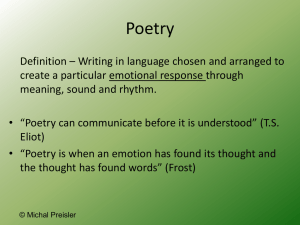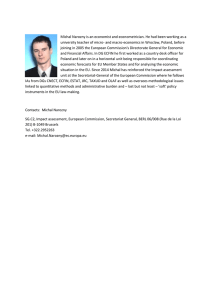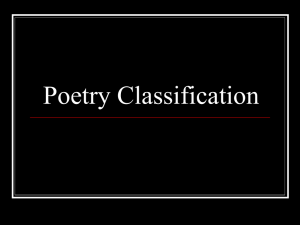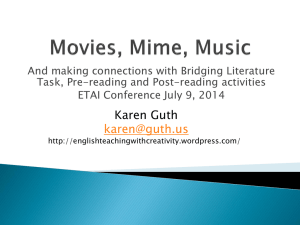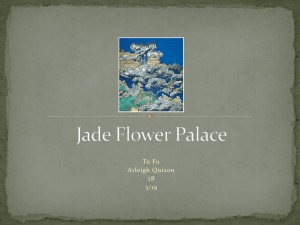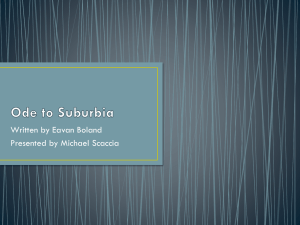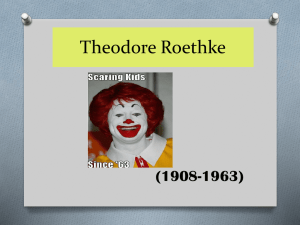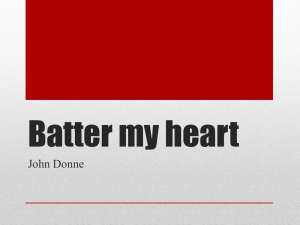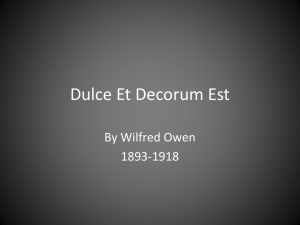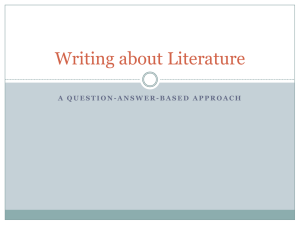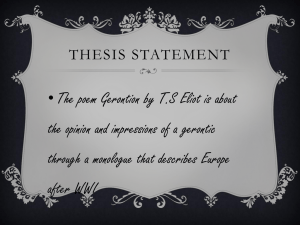The Road Not Taken by Robert Frost
advertisement
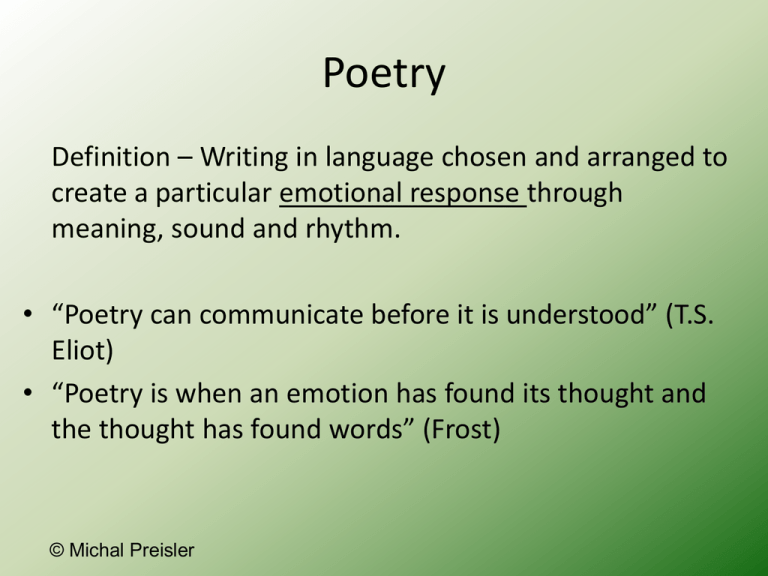
Poetry Definition – Writing in language chosen and arranged to create a particular emotional response through meaning, sound and rhythm. • “Poetry can communicate before it is understood” (T.S. Eliot) • “Poetry is when an emotion has found its thought and the thought has found words” (Frost) © Michal Preisler Robert Frost 1874-1963 Robert Frost was born in San Francisco, California but spent most of his life in New England, a rural area in the north east of the United States. The area is characterized by hills, woods, farms and small towns. Frost himself worked for many years as a farmer, in addition to teaching English and writing poems. His poems reflect the sights and sounds of where he lived, the fields, farms and woods and scenes of everyday life. All those elements make Frost’s poems accessible, leading readers to understand the deeper truths behind seemingly simple ideas © Michal Preisler Choice & Cost Every choice you make has a cost because choosing to do one thing means giving up the opportunity to do something else. Faced with the same options , different people make different choices because each person has his / her own way of making decisions based on different values and beliefs. When faced with the need to make a decision we try to think about the cost and guess the outcome. © Michal Preisler The Road Not Taken by Robert Frost © Michal Preisler © Michal Preisler The Road Not Taken By Robert Frost Two roads diverged in a yellow wood, And sorry I could not travel both And be one traveler, long I stood And looked down one as far as I could To where it bent in the undergrowth; And both that morning equally lay In leaves no step had trodden black. Oh, I kept the first for another day! Yet knowing how way leads on to way, I doubted if I should ever come back. Then took the other, as just as fair, And having perhaps the better claim, Because it was grassy and wanted wear; I shall be telling this with a sigh Somewhere ages and ages hence: Though as for that the passing there Two roads diverged in a wood, and I Had worn them really about the same, I took the one less traveled by, And that has made all the difference. © Michal Preisler http://www.youtube.com/wat ch?v=ZzUm0wqhE7E Which statement best summarizes the central idea of the passage? A. The narrator stands at a crossroads and is faced with the decision of which way to go in life. B. The narrator must decide which road he wants to travel on to get to his destination. C. The narrator is enjoying the autumn season and the beauty of the trees as he takes a walk. D. None of the above • What is the main dilemma in the poem? The speaker is at a fork in the road – he has to choose which way to go. • The fork in the road is a metaphor for a point in life when you need to make a choice. • A metaphor is a type of comparison in which one thing is described as if it was something else (example: life is a box of chocolates) © Michal Preisler Analysis and Literary Terms • What is the poem about ? • The answer is A. The narrator stands at a crossroads and is faced with a decision about which way to go in life • The poem is about a dilemma, the need to come to a decision / solve a problem © Michal Preisler The passage suggests all of the following as descriptions of the Path EXCEPT A. B. C. D. Yellow wood Grassy and wanted wear undergrowth cold Answer D. Cold The poem does not mention the temperature even though it does hint that it is autumn and the leaves are changing. What can we infer a “yellow wood” is? A. B. C. D. Sun in the trees Leaves changing in autumn Actually yellow trees None of the above Answer The inference is that the trees are changing for the season. It is Autumn and the paths are covered with leaves that “no step had trodden black.” From this line the word “trodden” most clearly means: A. B. C. D. Blown away Pushed Trampled Twisted Answer C. Trampled The author describes the leaves as not being “black” like they had not been walked on and trampled in the mud. Which of these is NOT an example of how the road is symbolic? A. B. C. D. The road represents choice The road is like life The road is beautiful The road has pros and cons • Is the speaker really standing in a forest thinking which way to go? • What does the road symbolize ? The road = Life, Choice, and Problem Solving The fact that it is beautiful doesn’t make it Symbolic. – Symbolism - the use of a concrete image (symbol) to represent an abstract idea. © Michal Preisler Which choice best describes the theme? A. B. C. D. Life is about Choices Life can be beautiful Life is complicated None of the above Answer A. Life is about Choices The author describes the Theme (lesson) about making choices, weighing the pros and cons and doing what is right even if you might sacrifice to do so. • How does the speaker solve his dilemma? – He compares the two roads – He weighs the pros and cons – He tries to foresee the future • Which road does he choose? – the less traveled by – The more adventurous / the less conventional ?? © Michal Preisler Read the these lines. What can we infer about the author’s choice? “I shall be telling this with a sigh Somewhere ages and ages hence” A. B. C. D. He is excited about his choice He is sad that he might miss something on the other road He is sure he will be happy to talk of his choice in the future None of the above • How do you think the speaker feels about his choice ? – Last stanza takes place in the future – Sigh of relief ? Sigh of regret ? – The “what if ??” • Why is the poem called “The Road NOT Taken” and not “The Road Taken” ? © Michal Preisler Consider the last stanza How do these sentences and the use of the word “sigh” and the phrase “made all the difference” reflect the author’s changing attitude towards his choice? Write your answer in complete sentences. Use evidence from the passage to support your response. The Last Stanza (4 Response) In the poem, “The Road Not Taken,” the author uses the words “sigh” and “made all the difference” to reflect his changing attitude towards his choice. In the text when the author says he will be telling his story with a “sigh”, he implies that he may be wistful (sad) that he did not take the other road, but then the author’s attitude changes when he acknowledges that the road he did take will have “made all the difference” in his life. This implies that while the author is sad that the other road (choice) could have had possibilities, he will still be grateful for the opportunities that he will have on the road (choice) he has chosen. Consider the text Describe how the author’s attitude toward the path symbolizes his changing attitude toward making choices throughout the poem. Use textual evidence from the passage to support your answer. Consider the Text In the poem “The Road Not Taken,” the author uses imagery of a path to portray his changing attitude about choice. In the poem it says the author is “sorry he could not travel both” paths. This image of two roads and a choice shows how the author is sad that he can not choose both paths in life, but has to only pick one. Later in the poem the author uses the image of the paths being “really about the same” to show that his choice is simple at first. His attitude changes to happy as he describes both paths as being beautiful with “leaves” that had not been “trodden black.” This image of a beautiful path in an autumn wood seems to be a change in attitude. However, his attitude shifts again with the description of the “sigh” for the future when he might regret what he missed on the other path because he doubted if he “should ever come back” to the path that he was passing up. The author’s attitude ends with a positive image that he would still be grateful for the path he took because it would “make all the difference” in his life.
